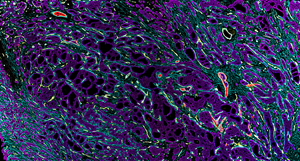-
Akoya to Partner with Nikon, CrestOptics and Andor to Enable New Spatial Biology Applications through the Imaging Innovators (I2) Network
来源: Nasdaq GlobeNewswire / 29 6月 2021 05:05:00 America/Los_Angeles
MARLBOROUGH, Mass., June 29, 2021 (GLOBE NEWSWIRE) -- Akoya Biosciences Inc., (Nasdaq: AKYA) The Spatial Biology Company®, today announced partnerships with premier microscope providers, Nikon, CrestOptics, and Andor to enable the development of new spatial biology applications, through the recently announced I2 Network. Akoya is the first spatial biology provider to publicly team up with multiple imaging companies to foster an ecosystem of novel innovations and applications on its platform.
“We are pleased to collaborate with Akoya to offer I2 researchers a cutting-edge imaging solution for spatial phenotyping applications. Nikon’s ECLIPSE Ti2 microscope features the industry’s largest field of view for maximizing data throughput. The Ti2’s open platform design enables users to easily configure the system with a wide variety of imaging modalities such as confocal and super-resolution, further extending the possibilities for spatial biology applications,” said Steve Ross, PhD, Director of Product & Marketing at Nikon Instruments, Inc.
Akoya plans to collaborate with its imaging partners to further expand integration of the CODEX® system with the latest and most advanced microscopy platforms. The benefits of the partnerships should include a more streamlined user experience, new workflows, faster acquisition speeds, and deeper resolution.
“We are excited with the possibilities that can result from pairing CODEX® with our spinning disk confocal, as the application is a perfect match for our core specifications: high resolution, large field of view and fast 3D imaging. Thanks to the flexibility of this solution, I2 researchers can easily turn their microscopes of choice into high dimensional spatial biology systems, enabling a whole new level of scientific discovery,” said Alessandra Scarpellini, PhD, Head of Sales and Marketing at CrestOptics.
“Multiplex in-situ imaging has enormous potential for life and medical science research. Andor is delighted to partner with Akoya, to provide I2 members with a unique set of high-performance 3D imaging, visualization and analysis tools. Dragonfly, our high speed confocal platform, offers large field of view and exceptional uniformity to deliver the highest quality volumetric data for quantitative studies into the spatial organization of proteins in tissues and cells,” said Mark Browne PhD, Director, Systems Division at Andor.
Through these strategic relationships, Akoya and its microscopy partners are paving the way for collaboration on new spatial biology applications. Researchers who are interested in using the CODEX system to develop novel, cutting-edge spatial biology applications can apply to be part of the I2 Network at www.akoyabio.com/isquare. Applications will be accepted until July 9.
“We are pleased that premier imaging brands like Nikon, CrestOptics, and Andor have chosen to partner with us,” said Brian McKelligon, President and CEO of Akoya Biosciences. “These partnerships underscore our commitment to broaden access to spatial biology and innovation on the CODEX® platform and ultimately accelerate the pace of breakthrough biological discoveries.”
For more information about the CODEX System, go to akoyabio.com/codex.
About Akoya Biosciences
As The Spatial Biology Company®, Akoya Biosciences’ mission is to bring context to the world of biology and human health through the power of spatial phenotyping. The company offers comprehensive single-cell imaging solutions that allow researchers to phenotype cells with spatial context and visualize how they organize and interact to influence disease progression and treatment response. Akoya offers two distinct solutions, the CODEX® and Phenoptics™ platforms, to serve the diverse needs of researchers across discovery, translational and clinical research. For more information, please visit www.akoyabio.com/.Cautionary Note Regarding Forward Looking Statements
This press release contains “forward-looking statements” under applicable securities laws. In some cases, such statements can be identified by words such as: “may," "will," "could," "would," "should," "expect," "intend," "plan," "anticipate," "believe," "estimate," "predict," "project," "potential," "continue," "ongoing" or the negative of these terms or other comparable terminology, although not all forward-looking statements contain these words. Forward-looking statements include express or implied statements regarding our ability to achieve our business strategies, growth, or other future events or conditions. Such statements are based on our current beliefs, expectations, and assumptions about future events or conditions, which are subject to inherent risks and uncertainties, including the risks and uncertainties discussed in the filings we make from time to time with the Securities and Exchange Commission. Actual results may differ materially from those indicated in forward-looking statements, and you should not place undue reliance on them. All statements herein are based only on information currently available to us and speak only as of the date hereof. Except as required by law, we undertake no obligation to update any such statement.Investor Contact:
David Deuchler
Gilmartin Group LLC
investors@akoyabio.comMedia Contact:
Michelle Linn
Bioscribe, Inc.
michelle@bioscribe.com
Photos accompanying this announcement are available athttps://www.globenewswire.com/NewsRoom/AttachmentNg/99c4d418-e583-49e6-b09d-290f5bb1ed65
https://www.globenewswire.com/NewsRoom/AttachmentNg/97f14a8d-ba8f-45f7-b386-d6a5799c17eb
Breast Cancer CODEX Tissue Image
Shown here is a breast cancer sample (FFPE) where 36 biomarkers were imaged from a single tissue section using the CODEX® system. This particular tissue is largely composed of luminal epithelial tissue (purple) with basal epithelial cells (red) and other epithelial cells in smaller proportions. The luminal vs basal subtypes can be indicative of prognosis and treatment response.
Breast Cancer CODEX Rare Cell Discovery
The CODEX® Solution can help researchers build comprehensive tissue maps for decoding disease biology. In this case, CODEX® detected the presence of a rare cell type (<0.1%, Ker8+/Ker14+), shown in the inset as red cells with a faint magenta outline, which had been previously reported only in healthy breast tissue. Researchers are still characterizing the role of this cell type in breast tissue behavior.

